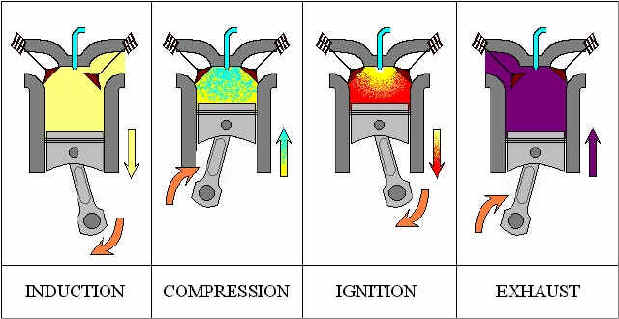COMBUSTION
Combustion occurs in diesel engines. As the
piston moves up and down in the cylinder, there is fuel
sprayed in at high pressures while the piston also creates
high-pressure air. When the fuel and air combust at the top of
the combustion chamber, a lot of Thermal energy is
released and forces the piston down. This cycle is repeated
over and over. This is what makes the crankshaft spin and give
the engine its rpm (Rotations per Minute). Thermal
energy is then converted into Mechanical energy as
the crankshaft is turned. Once again the torque of the pistons
will be rotating the crankshaft. This is the energy that will
eventually turn the flywheel, which can be hooked up for use
for movement, generation, and other uses.
The 4 steps of
combustion are shown below:
Intake- air is drawn into to cylinder by a down stroke of
the piston and the intake valve opening
Compression - the intake and exhaust valve are closed
as the piston compresses the air in the cylinder in an up
stroke, atomized fuel is also injected in
Combustion - the atomized fuel, and hot air are at a
very high pressure, causing them to ignite. This created a
small explosion which forces the piston back down
Exhaust-the exhaust valve opens letting the exhaust out
as the piston begins to start its up stroke, and the cycle
repeats over and over!
The bearings and bushing surround the rotating parts to reduce
Friction on the
rotating parts. This reduces wear on the interal parts of the
engine and lets more energy transfer from part-to-part. If
energy is not lost to friction, then more energy is
transferred into the cycle, therefore more output power is
created and efficiency goes up.
Efficiency is very important for fuel mileage
and engine performance !
Efficiency can be simply equated as (Power in) / ( Power out )
The more ouput power, the higher the efficiency.
